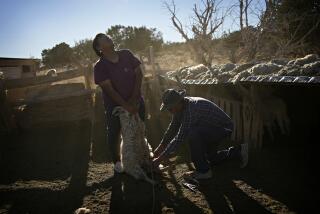Former Teacher Rides Herd on Buffalo Boom
- Share via
GOODING, Idaho — Thirty years ago, Vern France abandoned a teaching career after a short but illuminating student-teaching experience.
Today, his home north of Gooding sits next to a number of steel-reinforced pens containing 900 bison.
How does a man go from visions of spending his life penned in a roomful of young minds to minding pens of bison?
Ten years ago, when France was firmly entrenched in his cattle operation north of Gooding, he met Bud Flocchini. Head of an old-line Italian family in the San Francisco-area meat business for more than 100 years, Flocchini decided he wanted France to add bison to the ranch.
France rejected the offer several times, well aware of the labor required to implement a new operation. Finally, Flocchini persuaded him.
At one time, more than 30 million bison roamed the plains of America. By 1889, there were only 551 left, fewer than France has in his lot. The national herd now numbers 100,000, France said.
Upon arrival of his first herd, France quickly learned a few basics: Sick, weak and small animals must be penned together or the larger, stronger animals will destroy them. Until hierarchy is established, the bulls fight repeatedly. Once a group is settled, other animals aren’t added, or the battle begins again.
*
France said one couldn’t learn everything about bison in a lifetime, but as he warms to his subject, it’s obvious the teacher is still there.
Recently weaned calves to 2-year-old bulls constitute his herds. He keeps them about a year and does not keep any bulls older than 2.
He tells of the playfulness of the somewhat nocturnal animals, who play “King of the Mountain” games on dirt piles each evening. Bison may look clumsy, but they can move quickly and have enormous strength.
Six years ago, a mixture of calves to 3-year-old bulls was shipped from Santa Catalina Island to the lot. Used for a Western movie in the 1930s, the herd had roamed free and interbred for years. So they had smaller frames and lighter skeletons than average.
Penned for two months prior to shipment, France said, they were a motley crew upon arrival.
In the lots in Gooding, railroad ties had been buried, leaving several upright feet wrapped in barbed wire for the animals to use for scratching. One young bull hooked another, slamming him into the railroad tie and snapping it off. The victim was killed instantly. When the animal was parted out, France found the shoulder blade had been completely shattered.
Conversely, bison are discreet in mating habits, mating under cover of night. Cows calve in the presence of other cows, once necessary for protection from predators.
*
Bison carry 52% of their weight in front, 48% in back. Their coats are very fine and soft with stiff, longer guard hairs. France said if someone could figure out how to separate and gather shed hair, it could be woven into yarn.
Bulls attain full growth at 6 to 7 years old, reaching a height of 6 to 6 1/2 feet and weighing more than a ton. Because of their strength and endurance, it is difficult to tell when an animal is ill, France said.
In the presence of these majestic animals, it is difficult to believe that they are destined for slaughter, but the market is good.
Bison meat is nonallergenic, France said--and pricey. An acquaintance of France’s who wanted bison grilled for special friends paid $240 for 11 pounds.
The grill is not the only place the animals end up. Skulls are bleached and sold to American Indians, who paint and sell the finished product. Hooves and horns are ground to powder for an overseas aphrodisiac market. Tail switches are made into paintbrushes.
Bulls who manage to reach full growth end up on Flocchini property near Gillette, Wyo., France said. Hunting rights are sold to Europeans and Asians for $5,000.
More to Read
Sign up for Essential California
The most important California stories and recommendations in your inbox every morning.
You may occasionally receive promotional content from the Los Angeles Times.













